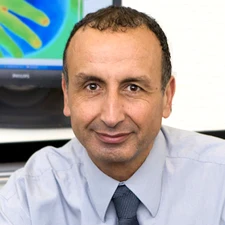Dani Or

The 2017 John Dalton Medal is awarded to Dani Or for groundbreaking, field-broadening contributions in soil hydro-physics and soil mechanics, for being instrumental in starting the field of soil biophysics, and for helping the research community advance scientific frontiers.
Dani Or is awarded the John Dalton Medal for a body of scientific work in soil hydrology, soil mechanics, and soil microbiology that is exceptionally broad, rigorous, and creative. His thorough understanding and use of physics, chemistry and mathematics blended into investigations of soils and subsurface environments that have yielded significant theoretical and practical contributions ranging from soil pore to landscape scales. His approach throughout his career can be summarised as seeking new solutions to new and emerging problems. Or has made pioneering and seminal contributions to the fundamental process understanding that initially focused on mass and energy distribution and transfer in porous media. Later he branched out into the interface of hydrology, biology and soil sciences by innovatively combining new theories and novel experiments, conducted in both the laboratory and field, leading to new insights into the functioning of this rich compartment of the biosphere. He has used his exceptional theoretical, mathematical, and experimental abilities to investigate many challenging problems and deliver with practical solutions. An incomplete list of his contributions illustrates the scope of Or’s research. He provided new insights of adsorption and capillary condensation in angular pores of porous media and quantified film and corner flow in their angular pore space. He increased our knowledge of the relationship between temperature sensitivity of capillary pressure and soil particle size, and modelled the hydraulic properties at the pore scale of macroporous soils and fractured rock. His pioneering analyses have provided a unified conceptual framework for equilibrium and non-equilibrium liquid configurations and fluid flow in dual-continuum pore networks, while his groundbreaking work on evaporation is of global significance (and highly relevant given the John Dalton legacy). Viewed from the perspective of porous media, he has revealed how evaporation from pores introduces nonlinearities responsible for the complex behaviour between evaporative fluxes and soil surface water content. Or has developed a pore-centric representation of joint evaporative fluxes and surface temperatures that has enabled predictions of energy partitioning over drying surfaces and prediction of the Bowen Ratio used in many remote sensing methods for estimation of surface fluxes. He advanced the mechanics of abrupt landslides and avalanches, leading to improved understanding of the triggering of landslides and an improved ability to detect increasing landslide risks. He also pioneered studies on the impact of the microbial carpet on the soil particle surfaces, with transfers of nutrients and energy at the pore scale quantified and experimentally verified. Because of hisresearch, hydrologists now have a much better understanding of the physical constraints affecting microbial habitats and activity in unsaturated porous media. This work on the physics of microbial habitats and rhizosphere helped many colleagues to re-focus their soil physics views and is instrumental to make soil biophysics a new field of soil science. Or also demonstrated leadership in opening up new frontiers of science through organising numerous topical conferences and workshops. He has been an associate editor of multiple journals and was Editor-in-Chief of the Vadose Zone Journal. He is also very much known for his excellence in student education.
